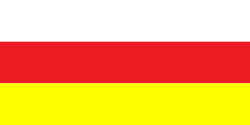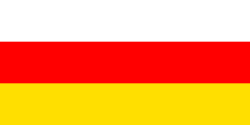Ossetians facts for kids
| Ир, Ирæттæ, Дигорæ, Дигорæнттæ / Ir, Irættæ, Digoræ, Digorænttæ | |
|---|---|

Ossetian folk dancer in North Ossetia (Russia), 2010
|
|
| Total population | |
| 700,000 | |
| Regions with significant populations | |
| 558,515 | |
| ( |
480,310 |
| 51,000 | |
(excluding South Ossetia P.A.) |
14,385 |
| 20,000–50,000 | |
| 7,861 | |
| 5,823 | |
| 4,830 | |
| 4,308 | |
| 2,066 | |
| 1,170 | |
| 758 | |
| 700 | |
| 554 | |
| 403 | |
| 331 | |
| 285 | |
| 119 | |
| 116 | |
| Languages | |
| Ossetian languages (Iron and Digor) Russian, Turkish, Arabic (L2) |
|
| Religion | |
| Majority: Minority: |
|
| Related ethnic groups | |
| Jász people of Hungary and other Iranian peoples | |
|
a. The total figure is merely an estimation; sum of all the referenced populations. |
|
The Ossetians are an ethnic group who live in a region called Ossetia. This area is located in the Caucasus Mountains. They speak Ossetic, which is an Eastern Iranian language. Many Ossetians also speak Russian.
Today, Ossetia is split into two main parts. One part is North Ossetia–Alania in Russia. The other part is South Ossetia, which is a country that some nations recognize as independent, but the United Nations sees it as part of Georgia.
The Ossetians are related to the Alans, an ancient group. Their closest relatives are the Jász people in Hungary. Another group, the Asud in Mongolia, also came from the Alans. However, only the Ossetians have kept their original language and identity.
Most Ossetians are Eastern Orthodox Christians. Smaller groups follow a traditional Ossetian religion called Uatsdin or are Muslims.
Contents
What's in a Name?
The name "Ossetians" comes from the Russians, who got it from the Georgians. The Georgians called them Osi or Oseti. This name likely came from an older word, As or Iasi, which was used by the Sarmatians, an ancient group related to the Ossetians.
For a long time, Ossetians didn't have one single name for themselves in their own language. They used names like Iron and Digoron for their different groups. But over time, they started to accept "Ossetian" as their common name.
In the 1990s, some Ossetian thinkers wanted a new name that would unite all subgroups. They chose Alania, which was the name of a medieval kingdom their ancestors, the Sarmatians, had. In 1994, North Ossetia officially added "Alania" to its name.
Ossetian Groups
Ossetians are divided into a few main groups:
- Iron
- This is the larger group, living in the east and south of Ossetia.
- They speak the Iron dialect.
- The Iron group includes smaller parts like the Alagirs, Kurtats, Tagaurs, Kudar, Tual, Urstual, and Chsan.
- The Kudar are the southern Ossetians.
- The Tual live in the central part of Ossetia.
- The Chsan are found in eastern South Ossetia.
- Digoron
- This group lives in the west.
- They speak the Digor dialect.
- Digors live in areas like Digora and Iraf districts, and some parts of Kabardino-Balkaria and Mozdok district.
- Iasi
- These Ossetians moved to the Jászság region in Hungary in the 1200s.
- They spoke the Jassic dialect, which is now extinct.
- Asud
- This was a group of nomadic people from Mongolia who also came from the Alans.
- Like the Iasi, they became part of the local culture and no longer speak an Ossetian dialect.
Culture and Traditions
Stories and Myths
Ossetian traditional stories come from their ancient Sarmatian roots. These stories often mix with local Christian beliefs. The most famous stories are about the Narts, who are legendary heroes. These tales are a big part of Ossetian folk mythology.
Music and Instruments
Ossetian folk songs have many different types, like:
- Historic songs (about the past)
- War songs (about battles)
- Heroic songs (about brave people)
- Work songs (for daily tasks)
- Wedding songs (for celebrations)
- Humorous songs (funny songs)
- Dance songs (for dancing)
- Romantic songs (about love)
- Lyrical songs (expressing feelings)
Ossetians use many interesting instruments:
- String Instruments:
- Dyuuadæstænon - a harp with twelve strings.
- Fændyr - a harp with two or three strings.
- Hysyn - a two or three-stringed fiddle.
- Hyyrnæg - a double-bridged instrument, like a cello.
- Wind Instruments:
- Uadyndz - a flute.
- Khyozyn - a reed flute.
- Lalym - bagpipes.
- Udaevdz - a double-reed instrument.
- Fidiuæg - an instrument made from a bull's horn.
- Percussion Instruments:
- Kartsgænæg - rattles.
- Gymsæg - a drum.
- Dala - a tambourine.
A Look at History
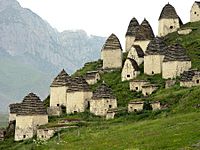
Ancient Roots: The Alans
The Ossetians are descendants of the Iazyges tribe, which was part of the Sarmatians. The Sarmatians themselves came from the larger Scythians. Around 200 AD, a group of Alans built a strong kingdom between the Don and Volga Rivers.
However, between 350 and 374 AD, the Huns attacked and split the Alan kingdom. Some Alans moved west and settled in places like France and Hungary. Others moved south to the Caucasus Mountains, where they created their own kingdom called Alania.
The Middle Ages
In the 8th century, a united Alan kingdom called Alania grew in the northern Caucasus Mountains. This kingdom was well-organized with a strong army and a good economy, helped by the Silk Road.
After the Mongol invasions in the 1200s, the Alans moved deeper into the Caucasus Mountains. There, they formed the three main Ossetian groups we know today: the Iron, the Digoron, and the Kudar. The Jassic people who went to Hungary in the 13th century are thought to be a fourth group.
Modern Times
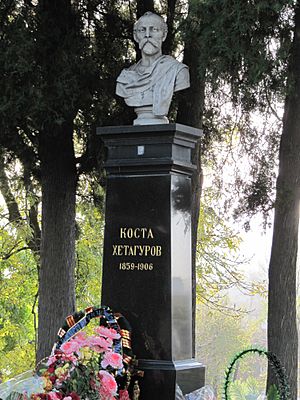
In more recent history, Ossetians have been involved in conflicts, such as the Ossetian–Ingush conflict (1991–1992) and conflicts with Georgia (in the early 1900s and early 1990s). They also played a role in the 2008 South Ossetia war between Georgia and Russia.
Here are some important dates:
- 1774: The Russian Empire began to expand into Ossetian lands.
- 1801: South Ossetia became part of the Russian Empire after Russia took over the Georgian kingdom of Kartli-Kakheti.
- 1922: The South Ossetian Autonomous Oblast was created. North Ossetia remained part of Russia, while South Ossetia was part of Georgia.
- September 20, 1990: The Republic of South Ossetia declared itself independent. Even though it wasn't officially recognized by many countries, it acted as a separate state from Georgia. Around this time, tensions between Ossetians and Georgians, and between Ossetians and Ingush, led to fighting and many people becoming refugees.
Since then, there have been ideas in South Ossetia about joining Russia and uniting with North Ossetia.
Language of the Ossetians
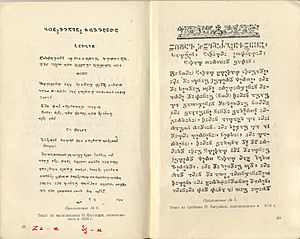
The Ossetian language is part of the Eastern Iranian group, which is a branch of the large Indo-European language family.
Ossetian has two main dialects:
- Ironian (Ирон) - spoken in North and South Ossetia. This is the most common dialect.
- Digorian (Дыгурон) - spoken in Western North Ossetia.
There are also smaller sub-dialects within these two groups. Ossetian is one of the last remaining languages from the ancient Scytho-Sarmatian group. It is unique and not easily understood by speakers of other Iranian languages.
Beliefs and Religion
| Religion in North Ossetia-Alania as of 2012 (Sreda Arena Atlas) | ||||
|---|---|---|---|---|
| Russian Orthodoxy | 49.2% | |||
| Assianism and other native faiths | 29.4% | |||
| Islam | 15% | |||
| Other Christians | 9.8% | |||
| Atheism and irreligion | 3% | |||
| Other Orthodox | 2.4% | |||
| Protestantism | 0.8% | |||
| Spiritual but not religious | 0.8% | |||
| Other and undeclared | 0.6% | |||
Before the 10th century, Ossetians mainly followed their traditional pagan beliefs. Around the 10th century, missionaries from the Byzantine Empire started to introduce Christianity. By the 13th century, many people in Ossetian towns became Eastern Orthodox Christians, partly due to missionaries from Georgia.
Islam arrived later, in the 1500s and 1600s. This happened when the Digor group of Ossetians met the Circassians, who had learned about Islam from the Tatars.
Today, most Ossetians in both North and South Ossetia are Eastern Orthodox Christians.
Assianism (also called Uatsdin or Aesdin) is the traditional Ossetian folk religion. It is still very popular among Ossetians. This religion includes special traditions like animal sacrifices, visiting holy shrines, and celebrating yearly festivals. There are special temples called kuvandon in most villages. In 2012, a survey showed that about 29% of people in North Ossetia practiced this folk religion. Its popularity has been growing since the 1980s.
Economy and Work
Ossetians in the northern part of the region often export lumber and grow crops, especially corn. Southern Ossetians mostly raise animals like sheep, goats, and other cattle. They also traditionally make leather goods, fur hats, daggers, and other metal items.
Where Ossetians Live
Besides South Ossetia, many Ossetians live in Trialeti in central Georgia. There are also many Ossetians living outside their homeland, forming a large diaspora. You can find Ossetian communities in Turkey, Syria, Belgium, France, Sweden, the United States (especially in New York City, Florida, and California), Canada (Toronto), Australia (Sydney), and other countries around the world.
Ossetians in Russia (2002 Census)
Most Ossetians live in Russia. Here are some of the main places they live, according to the 2002 Russian Census:
 North Ossetia–Alania — 445,300 people
North Ossetia–Alania — 445,300 people Moscow — 10,500 people
Moscow — 10,500 people Kabardino-Balkaria — 9,800 people
Kabardino-Balkaria — 9,800 people Stavropol Krai — 7,700 people
Stavropol Krai — 7,700 people Krasnodar Krai — 4,100 people
Krasnodar Krai — 4,100 people Karachay–Cherkessia — 3,200 people
Karachay–Cherkessia — 3,200 people Saint Petersburg — 2,800 people
Saint Petersburg — 2,800 people Rostov Oblast — 2,600 people
Rostov Oblast — 2,600 people Moscow Oblast — 2,400 people
Moscow Oblast — 2,400 people
Genetics and Ancestry
Ossetians are a unique group in the Caucasus region. They speak an Indo-Iranian language, while most of their neighbors speak different language families like Vainakh-Dagestani, Abkhazo-Circassian, or Turkic languages.
Studies of DNA show that North Ossetians are genetically more similar to other groups in the North Caucasus. South Ossetians are more similar to groups in the South Caucasus. However, when looking at female ancestry (mtDNA), Ossetians are more similar to some Iranian groups than to other Caucasian groups. This suggests that Ossetians originally came from a Proto-Iranian homeland, and then later, men from neighboring Caucasian groups joined their population.
Images for kids
-
Gaito Gazdanov, a famous Ossetian writer.
-
Valery Gergiev, a conductor.
See also
 In Spanish: Osetios para niños
In Spanish: Osetios para niños
- Alans
- Asud
- Digor (people)
- Iazyges
- Iron (people)
- Jassic people
- Alexander Kubalov
- Ossetians in Trialeti
- Ossetians in Turkey
- Peoples of the Caucasus
- Sarmatians
- Scythians
- Terek Cossacks


